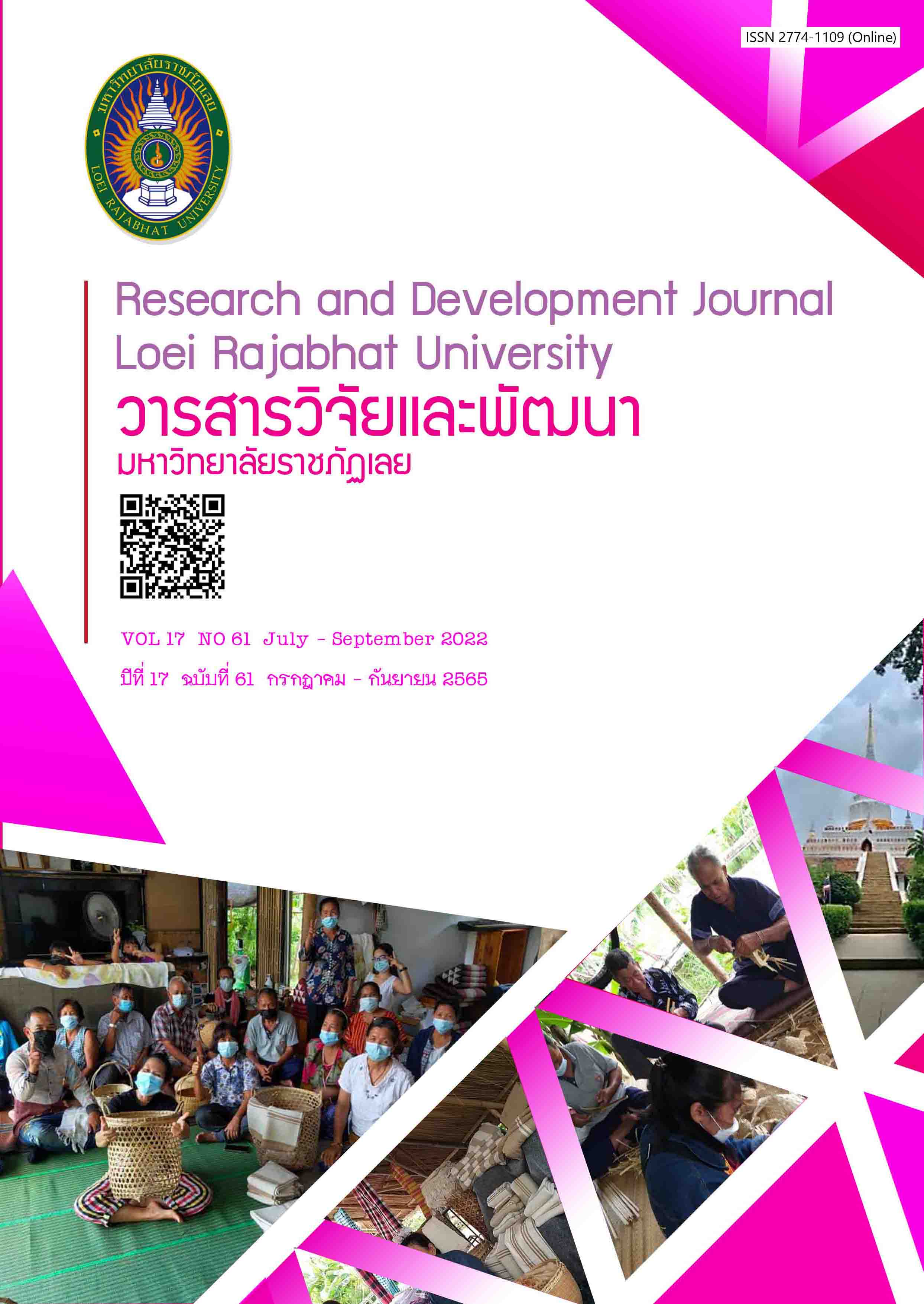Guidelines for Competency Development of Ban Kang Pla Fabric Weaving Community Enterprise Group in Chaiyapruek Sub-District, Mueang District, Loei Province
Keywords:
competency, community enterprise group of fabric weaving, Ban Kang Pla woven fabrics, Chaiyapruek sub-districtAbstract
This research was conducted by implementing a qualitative research methodology, and it aimed: 1) to study the context of the community enterprise of Ban Kang Pla fabric weaving group in Mueang District, Loei Province; and 2) to study the guidelines for developing the competency of Ban Kang Pla fabric weaving community enterprise group in Mueang District, Loei Province. The target group comprised 37 informants who were members of Ban Kang Pla fabric weaving community enterprise group, and community and cultural development scholars, and representatives of Chaiyapruek Sub-district Administrative Organization. Methods and tools used for collecting data were interview and meeting. Qualitative data was analyzed by content analysis. The results were as follows.
1. Community enterprise of Ban Kang Pla fabric weaving group adopted fabric weaving wisdom to generate income, and a specific pattern called "Kang Pla Pattern" was invented in 1982. Now, there are 32 members weaving plain colored fabrics, garments, and processing products. The group management emphasizes on participatory processes, strong leaders, continuous development of knowledge, and network creation cooperating with other enterprises in product distribution.
2. Guidelines for developing the competency of community enterprise of Ban Kang Pla fabric weaving group, there are 4 aspects needed to be implemented as follows: 1) local wisdom application and product development methods; 2) innovation creation and continual development to new products; 3) sustainability of products; and 4) marketing channel promotion.
References
เจณิภา คงอิ่ม. (2561). การดำเนินงานของผู้ประกอบการวิสาหกิจชุมชนในจังหวัดนนทบุรี. วารสารมนุษยศาสตร์และสังคมศาสตร์ มหาวิทยาลัยราชพฤกษ์, 4(1), 156-170.
ฐานันท์ ตั้งรุจิกุล, รัสมนต์ คำศรี, พาฝัน รัตนะ และ ไอริณ สกุลศักดิ์. (2559). ศึกษาศักยภาพการบริหารจัดการวิสาหกิจชุมชน กลุ่มผ้าทอนาหมื่นศรี จังหวัดตรัง. ใน การประชุมหาดใหญ่วิชาการระดับชาติครั้งที่ 7 (น.1326-1334). มหาวิทยาลัยหาดใหญ่, สงขลา.
ธงพล พรหมสาขา ณ สกลนคร และ อุทิศ สังขรัตน์. (2557). แนวทางการพัฒนาการดำเนินงานของวิสาหกิจชุมชนในเขตลุ่มทะเลสาบสงขลา. วารสารวิชาการคณะมนุษยศาสตร์และสังคมศาสตร์, 10(1), 97-122.
นงนุช อิ่มเรือง และ สถาพร มงคลศรีสวัสดิ์. (2554). แนวทางการพัฒนาศักยภาพวิสาหกิจชุมชนกลุ่มทอผ้าไหมบ้านหวายหล่ม. วารสารการบริหารท้องถิ่น, 4(2), 1-15.
นฤเบศ เลขกลาง. (2557). แนวทางการพัฒนากลุ่มอาชีพทอผ้าฝ้ายและตัดเย็บ บ้านโคกสูง ตำบลเชียงยืน อำเภอเชียงยืน จังหวัดมหาสารคาม. การประชุมวิชาการการพัฒนาชนบทที่ยั่งยืน ครั้งที่ 4 ประจำปี 2557 (น.177-182). มหาวิทยาลัยขอนแก่น, ขอนแก่น.
นฤมล พึ่งกิจ, วัชรินทร์ อินทพรหม, เตชิต ตรีชัย และ สิริกร ฉัตรภูติ. (2559). การพัฒนากลุ่มอาชีพสู่การเป็นวิสาหกิจชุมชนในเขตเทศบาลตำบลพุเตย จังหวัดเพชรบูรณ์. วารสารวิจัยราชภัฏพระนคร, 11(2), 201-214.
นิศารัตน์ สังข์เสือ และ พลดา เดชพลมาตย์. (2560). การบริหารจัดการวิสาหกิจชุมชน: กรณีศึกษากลุ่มผู้ผลิตเมล็ดพันธุ์ข้าวศรีนคร อำเภอศรีนคร จังหวัดสุโขทัย. นเรศวรวิจัย ครั้งที่ 13: วิจัยและนวัตกรรม ขับเคลื่อนเศรษฐกิจและสังคม บรรยาย (น. 68-87). มหาวิทยาลัยนเรศวร, พิษณุโลก.
พรทิภา ตันมาก และ สุวัลลีย์ เปี่ยมปิติ. (2554). ความสำเร็จของการส่งเสริมอาชีพของกลุ่มผลิตภัณฑ์บันตัน. วารสารการบริหารท้องถิ่น, 4(2), 43-58.
วรรณา โชคบันดาลสุข, กุลยา อนุโลก และ วรลักษณ์ ทองประยูร. (2558). การพัฒนากลยุทธ์การแข่งขันตามแนวทางเศรษฐกิจสร้างสรรค์สำหรับผ้าทอพื้นเมืองไทยทรงดำในจังหวัดราชบุรี. วารสารสมาคมนักวิจัย, 20(1), 62-73.
Downloads
Published
How to Cite
Issue
Section
License
Copyright (c) 2022 Research and Development Journal, Loei Rajabhat University

This work is licensed under a Creative Commons Attribution-NonCommercial-NoDerivatives 4.0 International License.
ข้อความที่ปรากฎในวารสารฉบับนี้เป็นความคิดเห็นของผู้เขียนแต่ละท่าน สถาบันวิจัยและพัฒนา มหาวิทยาลัยราชภัฏเลย และกองบรรณาธิการ ไม่จำเป็นต้องเห็นด้วยและไม่มีส่วนรับผิดชอบใดๆ
สถาบันวิจัยและพัฒนา มหาวิทยาลัยราชภัฏเลย ขอให้ผู้อ่านอ้างอิงในกรณีที่ท่านคัดลอกเนื้อหาบทความในวารสารฉบับนี้



